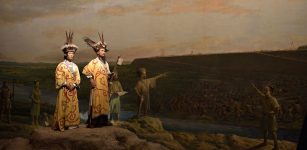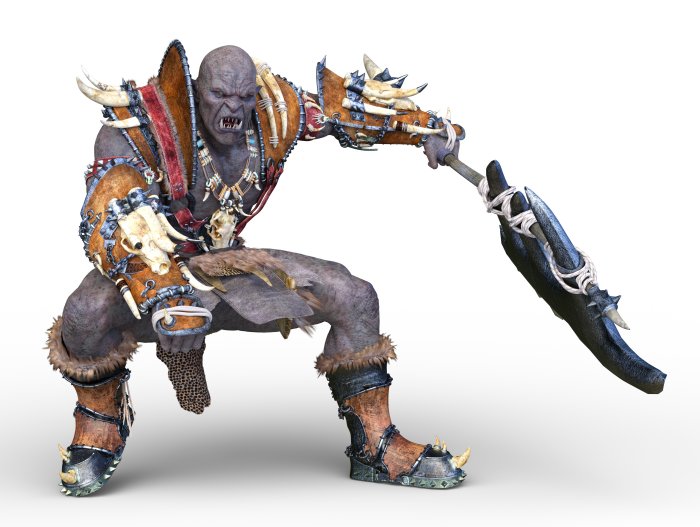Fomorians In Irish Myths And Legends: Race Of Demonic Giants Who Inhabited Ireland And Scotland
A. Sutherland - AncientPages.com - Celtic tradition describes the Fomorians as terrifying giant creatures, horribly deformed and often mistaken for demons.
It is said that this race of ugly beings descended from Noah's son Ham, whom Noah had cursed, and on account of this terrible curse, the Fomorians became one-legged and one-armed monstrous beings.
The Fomorians were superstitious and tyrannical; the people they conquered were either enslaved or forced, a crippling tribute of two-thirds of all children and cattle born.
Credit: Adobe Stock - tsuneomp
One Fomorian with stubby legs and long arms did not resemble another with a dwarfish right arm and a standard left arm or another with two or even three heads and only one eye or three on his head.
According to Fomorian beliefs, a child without any mutation is born without a noticeable personality. They were only accustomed to seeing their own mutated bodies, and a child born "normal" with all fingers and toes was doomed to be killed as a monster.
The Fomorians (Old Irish: 'Fomoire') is a supernatural race in Irish myths. These giants were associated with the powers of nature, such as fog, storms, winter, and disease.
They were said to have come from the sea or under its surface and were some of the earliest inhabitants of the British Isles, occupying both Scotland and Ireland.
Ireland had never seen anything more terrifying than the army of prehistoric Fomorians, who mercilessly raided and plundered Ireland from the sea.
The term 'Fomorian' was analogous to - disease, plague, and disaster.
The king of the Fomorians was Balor, a giant with an eye in the middle of his forehead.
According to tradition, they conquered the first invaders of Ireland - the Partholón (or "Parthalán") people who invaded Ireland and settled there, introducing cattle, building houses, and making all four plains cleared and habitable. After some years, they all died of the plague in a week.
Thirty years later came the Nemeds, who, like those who settled Ireland before him, had a genealogy going back to the biblical Noah. The Nemeds managed to win four battles with the Fomorians, but after nine years, thousands of the Nemeds died of the plague.
The mysterious Fomorians were again victorious until the Firbolgs, the third group of invaders, arrived and subdued the Fomorians. Firbolgs were the earliest historic race in Ireland. They were pastoral people of Greek or Eastern origin. Researchers believe they originated from a branch of the great Celtic race, which passed through Europe, rounded the continent's shores, and finally, made Ireland their resting place.
Credit: Adobe Stock - Digital Storm
The Firbolgs (from "Fir Bholg" – the "Men of Bags or Sacks") had a name given to them during their Greek exile. They lived peacefully with the Fomorians and most probably focused their lives on agriculture. They were forced to make arable land by covering rocks with earth, which they carried in bags.
They also preferred to avoid contact with other sentient races. They were both the most intelligent and powerful of the giant race.
The Tuatha De Danann defeated the Irish giants and attempted to forge a ceasefire with the Fomorians.
This attempt failed due to treachery from one side that resulted in a terrible war between the two races that ended in the Fomorians' downfall.
Written by – A. Sutherland AncientPages.com Senior Staff Writer
Updated on May 24, 2023
Copyright © AncientPages.com All rights reserved. This material may not be published, broadcast, rewritten or redistributed in whole or part without the express written permission of AncientPages.com
Expand for referencesMore From Ancient Pages
-
 Mysterious 7,000-Year-Old Circular Structure Near Prague Investigated By Scientists
Archaeology | Sep 14, 2022
Mysterious 7,000-Year-Old Circular Structure Near Prague Investigated By Scientists
Archaeology | Sep 14, 2022 -
 Norse Goddess Sif Who Lost Her Golden Hair Due To Loki’s Evil Deed
Featured Stories | Jun 30, 2018
Norse Goddess Sif Who Lost Her Golden Hair Due To Loki’s Evil Deed
Featured Stories | Jun 30, 2018 -
 Baku’s Mysterious Maiden Tower – Legend Of The Daughter Of Fire Who Saved The Sacred Temple May Be True
Featured Stories | Jul 5, 2021
Baku’s Mysterious Maiden Tower – Legend Of The Daughter Of Fire Who Saved The Sacred Temple May Be True
Featured Stories | Jul 5, 2021 -
 Ancient Liangzhu Culture Collapsed Due To Climate Change – New Study Says
Archaeology | Nov 25, 2021
Ancient Liangzhu Culture Collapsed Due To Climate Change – New Study Says
Archaeology | Nov 25, 2021 -
 Ancient Wooden Spade Found Under Melting Ice In Norway – Archaeologists Urge Hikers To Stay Alert
News | Sep 16, 2024
Ancient Wooden Spade Found Under Melting Ice In Norway – Archaeologists Urge Hikers To Stay Alert
News | Sep 16, 2024 -
 Mystery Of The Langeid Viking Sword And Its Undeciphered ‘Magical’ Inscriptions
Artifacts | Jun 4, 2022
Mystery Of The Langeid Viking Sword And Its Undeciphered ‘Magical’ Inscriptions
Artifacts | Jun 4, 2022 -
 Karahunge – ‘Speaking Stones’ With Secrets – Remarkable Prehistoric Structures Of Armenia
Places | Jun 4, 2020
Karahunge – ‘Speaking Stones’ With Secrets – Remarkable Prehistoric Structures Of Armenia
Places | Jun 4, 2020 -
 Mysterious Ancient Vanished Civilization With Unusual Physical Characteristics – Survivors Of The World’s First Race? – Part 1
Ancient Mysteries | Aug 17, 2020
Mysterious Ancient Vanished Civilization With Unusual Physical Characteristics – Survivors Of The World’s First Race? – Part 1
Ancient Mysteries | Aug 17, 2020 -
 Harappan Civilization Built Massive Protection Walls Against Tsunami 5,000 Years Ago
Archaeology | Jan 10, 2017
Harappan Civilization Built Massive Protection Walls Against Tsunami 5,000 Years Ago
Archaeology | Jan 10, 2017 -
 7,000-Year-Old Native American Underwater Burial Site Discovered Off The Coast Of Florida
Archaeology | Mar 3, 2018
7,000-Year-Old Native American Underwater Burial Site Discovered Off The Coast Of Florida
Archaeology | Mar 3, 2018 -
 Mystery Of The Gotland Grooves – Ancient Astronomical Observatory?
Civilizations | May 11, 2016
Mystery Of The Gotland Grooves – Ancient Astronomical Observatory?
Civilizations | May 11, 2016 -
 Three Judges Of Souls Await You On Chinvat Bridge – Gateway To Unknown Realms In Zoroastrian Beliefs
Featured Stories | Aug 11, 2021
Three Judges Of Souls Await You On Chinvat Bridge – Gateway To Unknown Realms In Zoroastrian Beliefs
Featured Stories | Aug 11, 2021 -
 Ancient Temple Dedicated To God Zeus Discovered In Sinai, Egypt
Archaeology | Apr 26, 2022
Ancient Temple Dedicated To God Zeus Discovered In Sinai, Egypt
Archaeology | Apr 26, 2022 -
 Eating And Social Habits Of People In The Balearic Islands 3,000 Years Ago – Reconstructed
Archaeology | Jan 18, 2023
Eating And Social Habits Of People In The Balearic Islands 3,000 Years Ago – Reconstructed
Archaeology | Jan 18, 2023 -
 Our Lives Have Always Been Manipulated By Money – Part 3
Featured Stories | Jun 8, 2022
Our Lives Have Always Been Manipulated By Money – Part 3
Featured Stories | Jun 8, 2022 -
 Solstices Brought Mayan Communities Together, Using Monuments Shaped By Science And Religion – And Kingly Ambitions, Too
Featured Stories | Jul 6, 2024
Solstices Brought Mayan Communities Together, Using Monuments Shaped By Science And Religion – And Kingly Ambitions, Too
Featured Stories | Jul 6, 2024 -
 Kahina – The Prophetic Berber Queen Who Resisted The Muslim Invasions Of The Numidia Kingdom
Featured Stories | Aug 14, 2021
Kahina – The Prophetic Berber Queen Who Resisted The Muslim Invasions Of The Numidia Kingdom
Featured Stories | Aug 14, 2021 -
 12,000-Year-Old Rock Art In North America – Dating Petroglyphs In The American West
Archaeology | Mar 4, 2022
12,000-Year-Old Rock Art In North America – Dating Petroglyphs In The American West
Archaeology | Mar 4, 2022 -
 A 200-Year-Old Swedish Mystery Remains Unsolved
Ancient Mysteries | Oct 7, 2015
A 200-Year-Old Swedish Mystery Remains Unsolved
Ancient Mysteries | Oct 7, 2015 -
 Ötzi Had Dark Skin, Bald Head And Anatolian Ancestry- DNA Reveals
Evolution | Aug 16, 2023
Ötzi Had Dark Skin, Bald Head And Anatolian Ancestry- DNA Reveals
Evolution | Aug 16, 2023


